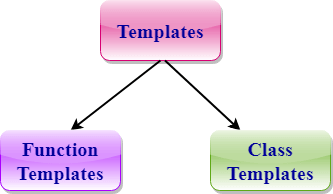TheDeveloperBlog.com
C-Sharp | Java | Python | Swift | GO | WPF | Ruby | Scala | F# | JavaScript | SQL | PHP | Angular | HTML
C++ Templates
C++ Templates with C++ tutorial for beginners and professionals with examples on constructor, if-else, switch, break, continue, comments, arrays, object and class, exception, static, structs, inheritance, aggregation etc.
C++ TemplatesA C++ template is a powerful feature added to C++. It allows you to define the generic classes and generic functions and thus provides support for generic programming. Generic programming is a technique where generic types are used as parameters in algorithms so that they can work for a variety of data types. Templates can be represented in two ways:

Function Templates: We can define a template for a function. For example, if we have an add() function, we can create versions of the add function for adding the int, float or double type values. Class Template: We can define a template for a class. For example, a class template can be created for the array class that can accept the array of various types such as int array, float array or double array. Function Template
Syntax of Function Template
template < class Ttype> ret_type func_name(parameter_list)
{
// body of function.
}
Where Ttype: It is a placeholder name for a data type used by the function. It is used within the function definition. It is only a placeholder that the compiler will automatically replace this placeholder with the actual data type. class: A class keyword is used to specify a generic type in a template declaration. Let's see a simple example of a function template:
#include <iostream>
using namespace std;
template<class T> T add(T &a,T &b)
{
T result = a+b;
return result;
}
int main()
{
int i =2;
int j =3;
float m = 2.3;
float n = 1.2;
cout<<"Addition of i and j is :"<<add(i,j);
cout<<'\n';
cout<<"Addition of m and n is :"<<add(m,n);
return 0;
}
Output: Addition of i and j is :5 Addition of m and n is :3.5 In the above example, we create the function template which can perform the addition operation on any type either it can be integer, float or double. Function Templates with Multiple ParametersWe can use more than one generic type in the template function by using the comma to separate the list. Syntax
template<class T1, class T2,.....>
return_type function_name (arguments of type T1, T2....)
{
// body of function.
}
In the above syntax, we have seen that the template function can accept any number of arguments of a different type. Let's see a simple example:
#include <iostream>
using namespace std;
template<class X,class Y> void fun(X a,Y b)
{
std::cout << "Value of a is : " <<a<< std::endl;
std::cout << "Value of b is : " <<b<< std::endl;
}
int main()
{
fun(15,12.3);
return 0;
}
Output: Value of a is : 15 Value of b is : 12.3 In the above example, we use two generic types in the template function, i.e., X and Y. Overloading a Function TemplateWe can overload the generic function means that the overloaded template functions can differ in the parameter list. Let's understand this through a simple example:
#include <iostream>
using namespace std;
template<class X> void fun(X a)
{
std::cout << "Value of a is : " <<a<< std::endl;
}
template<class X,class Y> void fun(X b ,Y c)
{
std::cout << "Value of b is : " <<b<< std::endl;
std::cout << "Value of c is : " <<c<< std::endl;
}
int main()
{
fun(10);
fun(20,30.5);
return 0;
}
Output: Value of a is : 10 Value of b is : 20 Value of c is : 30.5 In the above example, template of fun() function is overloaded. Restrictions of Generic FunctionsGeneric functions perform the same operation for all the versions of a function except the data type differs. Let's see a simple example of an overloaded function which cannot be replaced by the generic function as both the functions have different functionalities. Let's understand this through a simple example:
#include <iostream>
using namespace std;
void fun(double a)
{
cout<<"value of a is : "<<a<<'\n';
}
void fun(int b)
{
if(b%2==0)
{
cout<<"Number is even";
}
else
{
cout<<"Number is odd";
}
}
int main()
{
fun(4.6);
fun(6);
return 0;
}
Output: value of a is : 4.6 Number is even In the above example, we overload the ordinary functions. We cannot overload the generic functions as both the functions have different functionalities. First one is displaying the value and the second one determines whether the number is even or not. CLASS TEMPLATE
Class Template can also be defined similarly to the Function Template. When a class uses the concept of Template, then the class is known as generic class. Syntax
template<class Ttype>
class class_name
{
.
.
}
Ttype is a placeholder name which will be determined when the class is instantiated. We can define more than one generic data type using a comma-separated list. The Ttype can be used inside the class body. Now, we create an instance of a class class_name<type> ob; where class_name: It is the name of the class. type: It is the type of the data that the class is operating on. ob: It is the name of the object. Let's see a simple example:
#include <iostream>
using namespace std;
template<class T>
class A
{
public:
T num1 = 5;
T num2 = 6;
void add()
{
std::cout << "Addition of num1 and num2 : " << num1+num2<<std::endl;
}
};
int main()
{
A<int> d;
d.add();
return 0;
}
Output: Addition of num1 and num2 : 11 In the above example, we create a template for class A. Inside the main() method, we create the instance of class A named as, 'd'. CLASS TEMPLATE WITH MULTIPLE PARAMETERSWe can use more than one generic data type in a class template, and each generic data type is separated by the comma. Syntax
template<class T1, class T2, ......>
class class_name
{
// Body of the class.
}
Let's see a simple example when class template contains two generic data types.
#include <iostream>
using namespace std;
template<class T1, class T2>
class A
{
T1 a;
T2 b;
public:
A(T1 x,T2 y)
{
a = x;
b = y;
}
void display()
{
std::cout << "Values of a and b are : " << a<<" ,"<<b<<std::endl;
}
};
int main()
{
A<int,float> d(5,6.5);
d.display();
return 0;
}
Output: Values of a and b are : 5,6.5 Nontype Template ArgumentsThe template can contain multiple arguments, and we can also use the non-type arguments In addition to the type T argument, we can also use other types of arguments such as strings, function names, constant expression and built-in types. Let' s see the following example:
template<class T, int size>
class array
{
T arr[size]; // automatic array initialization.
};
In the above case, the nontype template argument is size and therefore, template supplies the size of the array as an argument. Arguments are specified when the objects of a class are created: array<int, 15> t1; // array of 15 integers. array<float, 10> t2; // array of 10 floats. array<char, 4> t3; // array of 4 chars. Let's see a simple example of nontype template arguments.
#include <iostream>
using namespace std;
template<class T, int size>
class A
{
public:
T arr[size];
void insert()
{
int i =1;
for (int j=0;j<size;j++)
{
arr[j] = i;
i++;
}
}
void display()
{
for(int i=0;i<size;i++)
{
std::cout << arr[i] << " ";
}
}
};
int main()
{
A<int,10> t1;
t1.insert();
t1.display();
return 0;
}
Output: 1 2 3 4 5 6 7 8 9 10 In the above example, the class template is created which contains the nontype template argument, i.e., size. It is specified when the object of class 'A' is created. Points to Remember
Next TopicC++ Tutorial
|
Related Links:
- C++ set key_comp() Function
- C++ set value_comp() Function
- C++ set find() Function
- C++ set count() Function
- C++ set lower_bound() Function
- C++ set upper_bound() Function
- C++ set equal_range() Function
- C++ set get_allocator() Function
- C++ set operator==
- C++ set operator!=
- C++ algorithm iter_swap() function
- C++ multiset equal_range() function
- C++ Program to Convert Number in Character
- C++ Program to Print Alphabet Triangle
- C++ Vector back() function
- C++ Program to Print Number Triangle
- C++ algorithm search() function
- C++ Program to Generate Fibonacci Triangle
- Top 39 C++ Interview Questions (2021)
- C++ multiset lower_bound() function
- C++ multiset upper_bound() function
- C++ multiset get_allocator() function
- C++ multiset operator==
- C++ algorithm adjacent_find() function
- C++ algorithm any_of() function
- C++ multiset non member operator greater than=
- C++ multiset swap() function
- C++ multiset operator!=
- C++ algorithm copy() function
- C++ algorithm remove_if() function
- C++ algorithm reverse_copy() function
- C++ algorithm copy_if() function
- C++ Math llrint() Function
- C++ Math tgamma() Function
- C++ Math lgamma() Function
- C++ Math nearbyint() Function
- C++ Math remainder() Function
- C++ Math remquo() Function
- C++ Math fabs() Functions
- C++ Math abs() Functions
- C++ Math fma() Function
- C++ Math fpclassify() Function
- C++ Math isgreaterequal() Function
- C++ algorithm count() function
- C++ algorithm count_if() function
- C++ algorithm equal() function
- C++ algorithm find_if() function
- C++ algorithm all_of() function
- C++ algorithm copy_backward() function
- C++ algorithm copy_n() function
- C++ algorithm is_permutation() function
- C++ algorithm mismatch() function
- C++ algorithm none_of() function
- C++ algorithm swap() function
- C++ algorithm fill() function
- C++ algorithm replace_copy_if() function
- C++ algorithm replace_copy() function
- C++ algorithm replace_if() function
- C++ algorithm transform() function
- C++ algorithm fill_n() function
- C++ set crend() Function
- C++ set empty() Function
- C++ set size() Function
- C++ set max_size() Function
- C++ Output Iterator
- C++ Programs
- C++ algorithm move_backward() function
- C++ algorithm reverse() function
- C++ algorithm find_if_not() function
- C++ Math isfinite() Function
- C++ Math isinf() Function
- C++ multiset operator less than
- C++ multiset non member operator less than=
- C++ multiset non member operator greater than
- C++ Math isnan() Functions
- C++ Math isnormal() Function
- C++ Math signbit() Function
- C++ Math isgreater() Function
- C++ Math less() Function
- C++ Math isunordered() Function
- C++ Math erf() Function
- C++ Math erfc() Function
- C++ set cbegin() Function
- C++ set end() Function
- C++ String rbegin() function
- C++ algorithm random_shuffle() function
- C++ algorithm remove_copy_if() function
- C++ Vector front() function
- C++ set
- C++ Stack
- C++ Queue
- C++ Stack empty() Function
- C++ Stack pop() Function
- C++ Queue emplace() Function
- C++ Queue empty() Function
- C++ Queue front() Function
- C++ algorithm is_sorted_until() function
- C++ algorithm is_sorted() function
- C++ algorithm rotate_copy() function
- C++ algorithm rotate() function
- C++ Stack push() Function
- C++ Stack size() Function
- C++ set swap() Function
- C++ set clear() Function
- C++ set emplace() Function
- C++ set emplace_hint() Function
- C++ algorithm merge() function
- C++ algorithm set_union() function
- C++ Queue pop() Function
- C++ Math cos() Function
- C++ Queue push() Function
- C++ set insert() Function
- C++ set erase() Function
- C++ algorithm find() function
- C++ Math sin() Function
- C++ Queue size() Function
- C++ multiset
- C++ Math tan() Function
- C++ Math log10() Function
- C++ String compare() function
- C++ Math acos() Function
- C++ String length() function
- C++ Math asin() Function
- C++ String swap() function
- C++ multiset constructor
- C++ Math atan() Functions
- C++ String size() function
- C++ set operator less than
- C++ set operator less than=
- C++ set operator greater than
- C++ Math atan2() Function
- C++ String resize() function
- C++ String replace() function
- C++ multiset clear() function
- C++ multiset emplace() function
- C++ multiset erase() function
- C++ multiset destructor
- C++ multiset begin() function
- C++ multiset end() function
- C++ multiset operator= function
- C++ multiset rbegin() function
- C++ multiset crbegin() function
- C++ algorithm partial_sort() function
- C++ algorithm sort() function
- C++ multiset swap() function
- C++ multiset rend() function
- C++ multiset cbegin() function
- C++ multiset cend() function
- C++ multiset emplace_hint() function
- C++ multiset find() function
- C++ History
- C++ Features
- C++ set operator greater than=
- C++ set swap() Function (Non-member)
- C++ String max_size() function
- Turbo C++ - Download and Installation
- C++ Program
- C++ Basic Input Output (cin, cout, endl)
- C++ Variable
- C++ Object Class
- C++ Vector rbegin() function
- C++ Data types
- C++ Keywords
- C++ Vector clear() function
- C++ Vector max_size() function
- C++ Operators
- C++ if-else
- C++ switch
- C++ For Loop
- C++ While Loop
- C++ Math cosh() Function
- C++ Do-While Loop
- C++ Math sinh() Function
- C++ Break Statement
- C++ Math tanh() Function
- C++ Continue Statement
- C++ Math acosh() Function
- C++ Goto Statement
- C++ Math asinh() Function
- C++ Math atanh() Function
- C++ Comments
- C++ Math exp() Function
- C++ Math frexp() Function
- C++ Math log() Function
- C++ Functions
- C++ Math modf() Function
- C++ Recursion
- C++ Storage Classes
- C++ Forward Iterator
- C++ Input Iterator
- C++ Math exp2() Function
- C++ multiset key_comp() function
- C++ algorithm unique_copy() function
- C++ Math llround() Function
- C++ Arrays
- C++ Passing Array to Function
- C++ Multidimensional Arrays
- C++ Pointers
- C++ OOPs Concepts
- C++ Constructor
- C++ Copy Constructor
- C++ Destructor
- C++ algorithm upper_bound() function
- C++ this Pointer
- C++ static
- C++ Structs
- C++ Enumeration
- C++ friend function
- C++ Math Functions
- C++ Inheritance
- C++ Aggregation
- C++ Polymorphism
- C++ Overloading
- C++ algorithm lower_bound() function
- C++ Vector
- C++ Math expm1() Function
- C++ Math log1p() Function
- C++ Math log2() Function
- C++ String append() function
- C++ Tutorial | Learn C++ Programming
- C++ multiset crend() function
- C++ multiset empty() function
- C++ multiset insert() function
- C++ Math logb() Function
- C++ String at() function
- C++ Math scalbn() Function
- C++ String find() function
- C++ Math scalbln() Function
- C++ String find_first_of() function
- C++ algorithm replace() function
- C++ algorithm swap_ranges() function
- C++ Math ilogb() Function
- C++ String find_first_not_of() function
- C++ Math copysign() Function
- C++ String find_last_of() function
- C++ Math nextafter() Function
- C++ String find_last_not_of() function
- C++ Math nexttoward() Function
- C++ String insert() function
- C++ String push_back() function
- C++ String assign() function
- C++ algorithm search_n() function
- C++ algorithm generate_n() function
- C++ String copy() function
- C++ algorithm find_end() function
- C++ algorithm find_first_of() function
- C++ algorithm generate() function
- C++ algorithm remove() function
- C++ algorithm is_partitioned() function
- C++ String begin() function
- C++ String cbegin() function
- C++ String cend() function
- C++ String clear() function
- C++ String crbegin() function
- C++ Function Overriding
- C++ virtual function
- C++ vs C#
- C++ Convert int to string
- C++ Components of STL
- C++ String Data() function
- C++ String empty() function
- C++ Algorithm
- C++ Iterators
- C++ Bidirectional Iterator
- C++ Namespaces
- C++ Strings
- C++ String erase() function
- C++ Stack emplace() Function
- C++ Exception Handling
- C++ String front() function
- C++ vs Java
- C++ try-catch
- C++ String operator+=() function
- C++ multiset value_comp() function
- C++ multiset count() function
- C++ User-Defined Exceptions
- C++ Templates
- C++ Signal Handling
- C++ File and Stream
- C++ String operator=() function
- C++ String operator[]() function
- C++ String rfind() function
- C++ String end() function
- C++ String capacity() function
- C++ String shrink_to_fit() function
- C++ String crend() function
- C++ algorithm shuffle() function
- C++ algorithm stable_partition() function
- C++ String reserve() function
- C++ String pop_back() function
- C++ Vector at() function
- C++ String c_str() function
- C++ Vector swap() function
- C++ Vector push_back() function
- C++ Vector pop_back() function
- C++ Vector empty() function
- C++ set destructor
- C++ set operator=() Function
- C++ set begin() Function
- C++ Vector insert() function
- C++ Stack top() Function
- C++ Queue back() Function
- C++ Vector erase() function
- C++ String back() function
- C++ String rend() function
- C++ Vector resize() function
- C++ Vector size() function
- C++ Vector capacity() function
- C++ Math islessgreater() Function
- C++ Vector assign() function
- C++ Vector operator=() function
- C++ Vector operator[]() function
- C++ Vector end() function
- C++ Vector emplace() function
- C++ Vector emplace_back() function
- C++ Vector rend() function
- C++ Vector begin() function
- C++ Vector cend() function
- C++ Vector cbegin() function
- C++ Math fdim() Function
- C++ Vector crbegin() function
- C++ Math fmax() Function
- C++ Vector crend() function
- C++ Math fmin() Function
- C++ Vector data() function
- C++ Vector shrink_to_fit() function
- C++ Math pow() Function
- C++ algorithm unique() function
- C++ Math sqrt() Function
- C++ Math cbrt() Function
- C++ Math islessequal() Function
- C++ Math hypot() Function
- C++ Math ceil() Functions
- C++ algorithm for_each() function
- C++ multiset max_size() function
- C++ multiset size() function
- C++ Math floor() Function
- C++ set constructor
- C++ Math round() Function
- C++ algorithm equal_range() function
- C++ algorithm includes() function
- C++ algorithm inplace_merge() function
- C++ Math lround() Functions
- C++ algorithm partition_copy() function
- C++ algorithm partition_point() function
- C++ algorithm partition() function
- C++ Math fmod() Function
- C++ Program to Reverse Number
- C++ Math trunc() Function
- C++ Program to Swap Tow Number Without Third Variable
- C++ algorithm stable_sort() function
- C++ algorithm binary_search() function
- C++ Math rint() Function
- C++ Program to Convert Decimal to Binary
- C++ Math lrint() Function
- C++ algorithm nth_element() function
- C++ algorithm partial_sort_copy() function
- C++ set cend() Function
- C++ set rbegin() Function
- C++ set rend() Function
- C++ set crbegin() Function
- C++ algorithm move() function
- C++ algorithm remove_copy() function


